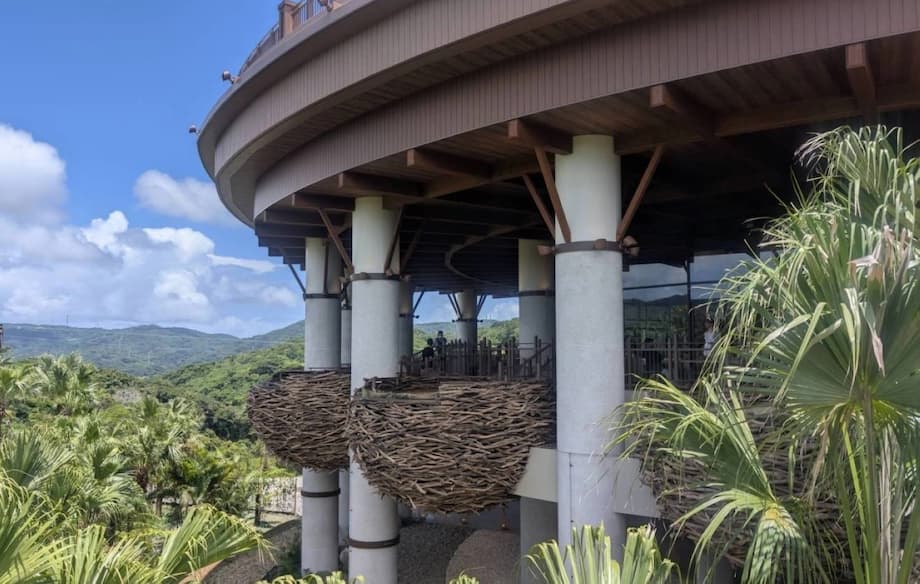Junglia: A Jurassic Adventure in the Heart of Okinawa
In the lush, subtropical wilderness of northern Okinawa, a colossal brachiosaur’s head peeks above the treetops, signaling the arrival of Japan’s newest and most ambitious theme park: Junglia. Opened on July 25, 2025, Junglia is not just another amusement park—it’s a sprawling, nature-immersive destination that blends the thrill of prehistoric encounters with the tranquility of a luxury resort. Developed on a former golf course in Nakijin Village, this 60-hectare (600,000 square meter) park is poised to transform Okinawa’s tourism landscape and redefine what a theme park can be in Japan.
- Junglia: A Jurassic Adventure in the Heart of Okinawa
- What Makes Junglia Unique?
- Dinosaurs in the Jungle: The Star Attractions
- Beyond Dinosaurs: Adventure, Relaxation, and Luxury
- Dining and Shopping: A Taste of Okinawa
- Nighttime Entertainment and Special Events
- Ticketing, Pricing, and Access: What You Need to Know
- Economic Impact and Regional Revitalization
- Challenges: Remote Location, Crowds, and Growing Pains
- Financial Scrutiny and Corporate Transparency
- Comparisons and Industry Context
- Visitor Tips: Making the Most of Your Junglia Experience
- In Summary
What Makes Junglia Unique?
Unlike the urban sprawl of Tokyo Disneyland or Universal Studios Japan, Junglia is nestled within the wild Yanbaru region, a UNESCO World Natural Heritage site renowned for its biodiversity. The park’s design intentionally integrates with the surrounding jungle, featuring more than 30,000 newly planted trees and open-air attractions that immerse visitors in Okinawa’s natural beauty. The concept, dubbed “Power Vacance!!” (Energy Vacation), aims to awaken the senses and offer a refreshing escape from city life.
Junglia’s vision is ambitious: to attract not only domestic tourists but also the vast market of two billion people within a four-hour flight from Okinawa, including visitors from China, South Korea, and Hong Kong. With a ¥70 billion (approximately $470 million) investment, the park is expected to generate significant economic impact, create jobs, and revitalize the northern part of Okinawa, which has traditionally seen fewer tourists than the bustling south.
Dinosaurs in the Jungle: The Star Attractions
The headline draw at Junglia is the Dinosaur Safari, a 17-minute off-road adventure where guests board rugged vehicles and plunge into a prehistoric world. Along the route, up to 20 life-sized animatronic dinosaurs—including a towering 19-meter-tall Brachiosaurus and a menacing T-Rex—lurk among the foliage. The experience is designed to be cinematic, with moments where visitors disembark to join park rangers in a dramatic “escape” from the dinosaurs, blurring the line between theme park ride and immersive theater.
For families with younger children, the Finding Dinosaurs attraction offers a gentler adventure, guiding kids through the forest to help reunite lost baby dinosaurs with their parents. These dinosaur-themed experiences set Junglia apart from other parks in Japan, tapping into the enduring fascination with prehistoric creatures and the global popularity of franchises like Jurassic Park.
Beyond Dinosaurs: Adventure, Relaxation, and Luxury
Junglia’s appeal extends far beyond its dinosaur encounters. The park boasts 22 major attractions, catering to thrill-seekers, families, and those seeking relaxation alike. Notable highlights include:
- Horizon Balloon: A hot air balloon ride that soars 200 meters above the jungle, offering 360-degree panoramic views of Okinawa’s coastline and forests. Guests can even enjoy a glass of sparkling wine as they take in the scenery.
- Sky Phoenix: A high-speed zipline that lets visitors glide through the Yanbaru forest canopy, providing a bird’s-eye view of the park’s lush landscape.
- Titan’s Swing: A giant swing that sweeps riders over the treetops at thrilling speeds.
- Buggy Voltage: An all-terrain vehicle course for adventurous drives through the jungle.
- Gravity Drop, Bungee Glider, and Human Arrow: Heart-pounding rides that combine elements of bungee jumping, ziplining, and elastic launches.
- Spa Junglia: A luxurious spa complex featuring the world’s largest public infinity bath (certified by Guinness World Records), outdoor saunas, rock baths, cave baths, and natural hot springs—all with breathtaking views of the surrounding jungle.
For those seeking a more relaxed pace, the Tam Tam Tram offers a scenic ride through the park, while the Yanbaru Friends interactive theater introduces visitors to Okinawa’s unique ecology through local animal characters and storytelling.
Dining and Shopping: A Taste of Okinawa
Junglia elevates the theme park dining experience with 15 eateries, including three full-service restaurants and a dozen food carts scattered throughout the grounds. Panorama Dining stands out with its glass-walled, bird’s nest-inspired seating, offering sweeping views of the jungle. The menu features local specialties such as hamburg steak wrapped in bacon, fresh Okinawan fish, and green harvest pizza topped with salt-cured pork and seafood.
For a more upscale meal, Tropical Oasis (attached to Spa Junglia) serves tapas made from local ingredients, Iejima Hizakura beef marinated in miso, island curry, and pasta. Food cart options range from tropical-inspired snacks to sweets, ensuring there’s something for every palate.
Shopping is also a key part of the Junglia experience. The Village Bazaar offers over 550 items, including tableware, clothing, Okinawan treats, and unique souvenirs. Visitors can also pick up dinosaur headgear and tropical flower accessories to get into the spirit of their jungle adventure.
Nighttime Entertainment and Special Events
As the sun sets, Junglia transforms with nightly fireworks displays, live music, and acrobatic performances. The Junglia Night Fes and Wild Beat events keep the energy high, while immersive sound-and-light shows and interactive theater experiences engage guests of all ages. These nighttime offerings are designed to extend the park’s appeal beyond daylight hours and create lasting memories for visitors.
Ticketing, Pricing, and Access: What You Need to Know
Junglia operates a two-tiered pricing system that has sparked discussion among visitors and industry observers. Japanese residents pay ¥6,930 (about $45) for adults and ¥4,950 for children aged 4-11, while foreign tourists are charged ¥8,800 (about $60) for adults and ¥5,940 for children. The distinction is based on residency, not ethnicity—foreign residents of Japan can access local pricing by presenting proof of residence. Combo tickets that include both park and spa access are also available, as are premium passes that allow guests to skip lines at select attractions.
This pricing strategy is intended to keep the park affordable for locals while leveraging the willingness of international tourists to pay higher prices, especially given the weak yen. While this approach is not unprecedented in Japan, it is unusual for a major theme park and has drawn attention for its transparency and potential impact on visitor demographics.
Tickets must be purchased online in advance, and parking (reservation-only) costs ¥2,000 per day. The park is accessible via shuttle buses from major locations such as Naha Airport, Nago City Hall, partner hotels, and the Okinawa Churaumi Aquarium. Exploring Okinawa by car is recommended for those wishing to visit Junglia and other northern attractions.
Economic Impact and Regional Revitalization
Junglia is more than a theme park—it’s a strategic initiative to boost the economy of northern Okinawa and distribute tourism more evenly across the island. Traditionally, most of Okinawa’s nearly 10 million annual visitors have concentrated in the southern areas like Naha. By creating a world-class attraction in the north, Junglia aims to draw tourists to less-visited regions, supporting local businesses and creating jobs in hospitality, transportation, and retail.
Approximately 70% of Junglia’s operating company shareholders are Okinawan firms, including Orion Beer and Ryubo Holdings, ensuring that a significant portion of tourism revenue remains on the island. Economic studies by Kansai University estimate that Junglia could generate ¥6.8 trillion (about $42 billion) in economic impact over the next 15 years, through job creation, regional branding, and increased tourism.
The park’s development has also involved collaboration with local governments and stakeholders, with an eye toward inspiring further attractions and infrastructure improvements in the region. Junglia’s success could serve as a model for sustainable tourism and regional revitalization in other parts of Japan.
Challenges: Remote Location, Crowds, and Growing Pains
Despite its promise, Junglia’s debut has not been without challenges. The park’s remote location in the rugged Motobu Peninsula means that access is limited to a pair of two-lane roads, with little signage or themed decor along the way. This can make the journey feel uncertain for first-time visitors, though the sight of a brachiosaur above the treetops provides a memorable welcome.
Early visitor feedback has been mixed. While many praise the park’s visual design, immersive concept, and unique attractions, others have criticized long wait times, crowded conditions, and difficulties navigating the expansive grounds. According to a survey by the Ryukyu Shimpo newspaper, 74% of guests during the opening days reported experiencing only two or fewer attractions in a full-day visit, with the highest number being four. Half of respondents rated their experience at the lowest levels on a five-point scale, citing issues such as lack of shelter from rain and wind, and the need for more efficient operations.
Operational hiccups are not uncommon for new theme parks, and Junglia’s management has acknowledged the need to improve guest flow and weather protection. The park’s team, led by Tsuyoshi Morioka—renowned for revitalizing Universal Studios Japan—faces the challenge of delivering on the park’s ambitious vision while addressing practical concerns.
Financial Scrutiny and Corporate Transparency
Junglia’s opening has also attracted scrutiny regarding its financial management and governance. Investigative reports by NewsPicks raised questions about the financial health of Katana Inc., the park’s developer, and its relationship with consulting firms linked to CEO Tsuyoshi Morioka. Katana reported a net loss of ¥2.4 billion for fiscal 2024, and concerns were raised about payments to related entities.
Katana and the government-backed Cool Japan Fund, which invested ¥8 billion in the project, have publicly denied any misuse of funds, stating that all investments were directed to the operating company managing Junglia. However, some details remain confidential, and the company’s ability to achieve long-term profitability will be closely watched.
Comparisons and Industry Context
Junglia’s scale and ambition place it among the largest theme parks in Japan, surpassing Tokyo Disneyland (51 hectares) and Universal Studios Japan (54 hectares) in size. Its focus on nature immersion, adventure sports, and wellness sets it apart from traditional parks, aligning with global trends toward experiential and eco-friendly tourism.
The park’s development was spearheaded by Tsuyoshi Morioka, whose previous successes include introducing the Wizarding World of Harry Potter to Universal Studios Japan. Many of Junglia’s team members bring extensive theme park experience, and the park’s innovative approach could influence future projects in Japan and beyond.
Visitor Tips: Making the Most of Your Junglia Experience
For those planning a visit, here are some practical tips:
- Book tickets and parking in advance—the park often sells out, especially during peak travel seasons.
- Prepare for the weather—walkways are not covered, so bring a parasol, sunscreen, or rain gear as needed.
- Expect to walk—the park is vast, and while the Tam Tam Tram offers some relief, much of the exploration is on foot.
- Consider premium passes to skip lines at popular attractions, especially if visiting during busy periods.
- Plan your meals—reservations are recommended for Panorama Dining and other popular restaurants.
- Check spa policies—Spa Junglia is not tattoo-friendly, and tickets are sold separately from park admission.
With thoughtful planning, visitors can maximize their enjoyment and experience the full range of what Junglia has to offer.
In Summary
- Junglia is Okinawa’s first large-scale theme park, blending dinosaur adventures, nature immersion, and luxury amenities.
- The park features 22 attractions, including a Dinosaur Safari, hot air balloon rides, zip lines, and a world-record infinity spa.
- Developed with a ¥70 billion investment, Junglia aims to revitalize northern Okinawa and attract both domestic and international tourists.
- Junglia operates a two-tiered pricing system, with higher ticket prices for foreign tourists than for Japanese residents.
- Early reviews praise the park’s concept and design but note operational challenges such as long wait times and weather exposure.
- Junglia’s success could have significant economic impact, creating jobs and supporting local businesses in Okinawa.
- The park’s innovative approach and focus on sustainability may influence future theme park development in Japan and Asia.




